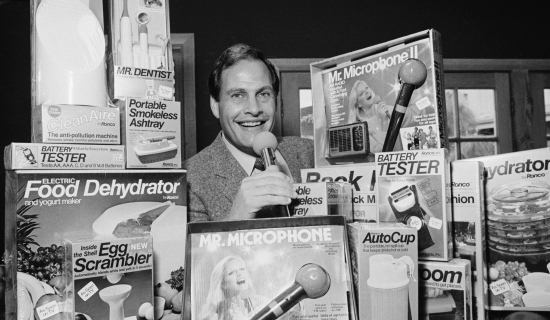THE Ghost of Christmas Presents Past – Number Three: Mr Microphone
LAST month we looked at the K-Tel “Various Artists” compilation albums that took Britain by storm in the Seventies. But that wasn’t the end of the story.
K-Tel was the brainchild of Philip Kives, a salesman from Winnipeg. In the mid-sixties he was flogging new-fangled Teflon pans by demonstrating them on TV. It worked a treat, so he went to Australia, where he used the same method to shift a million knives in five months, making a profit of a million dollars.
This didn’t go down too well with his supplier, Seymour Popeil, who refused to do business with him after that. Kives responded by temporarily shifting his attention to records, releasing 25 Great Country Artists Singing Their Original Hits in Canada. Then he set up K-Tel, which sold both gadgets and records, and pushed both with maximum energy and minimum subtlety.
K-Tel’s success prompted Seymour Popeil’s son to set up a rival record label. His name was Ron, and he called his company Ronco. Like K-Tel it sold 10-songs-a-side hit albums, but also inspired one-offs such as a version of Handel’s Messiah whose sleeve doubled as a pop-up Nativity ornament.
Ron didn’t stop there, though. No, sir! His company soon became infamous for its idiosyncratic, not to say downright weird, gadgets invented by Ron and his father. The Buttoneer was a device that stapled buttons onto garments, the Record Vacuum vacuumed your records, and the Inside-The-Shell Egg Scrambler did exactly what it said on the, er, shell. Then there was the Beauty-Rite Plastic Plant Maker, for “realistic-looking plastic plants that never need watering” and the Food Glamorizer, which turned “any meal into a feast fit for a king”.
All were accompanied by garish, shouty ads with catchphrases such as, “But wait, there’s more!” By the mid-Seventies they were so well known that Dan Akroyd was parodying their hard-sell techniques on Saturday Night Live with the Bass-o-Matic, which blended a whole bass into a nutritious fishy drink.
Pride of place, however, must go to the curiously named Mr Microphone – a microphone that allowed you to hear your own voice on the radio, as long as you were near enough to the radio to hear it above the sound of your actual voice. Of course the ads put it slightly differently. The American version sold it as a way of picking up girls, while the British presented it as nothing less than the life and soul of the party…
The scene: a cocktail party filmed in blurred, garish colour. A man and woman are talking when another man shoves a bulbous microphone into their faces and says: “Testing! Testing!”
Instead of punching him, the first man grabs the mic and shouts, “Hey, I’m on the radio!” in an enthusiastic Tony Blackburn-style voice.
Cut to a bunch of kids holding mics and singing Jingle Bells.
Announcer: “These kids are having a wonderful time with Mr Microphone, the microphone that puts your voice on the radio!”
Cut to a family swaying and singing on a sofa, with a tiny transistor radio on the coffee table in front of them.
Announcer: “It’s great fun for all the family!’
Cut to picture of Mr Microphone box, with “£9.95” flashing in the corner of the screen.
And that was it. Go figure, as they say.
Three people died in the Mr Microphone stampedes that Christmas.
Ed Barrett
Would you like to support Flashbak?
Please consider making a donation to our site. We don't want to rely on ads to bring you the best of visual culture. You can also support us by signing up to our Mailing List. And you can also follow us on Facebook, Instagram and Twitter. For great art and culture delivered to your door, visit our shop.







